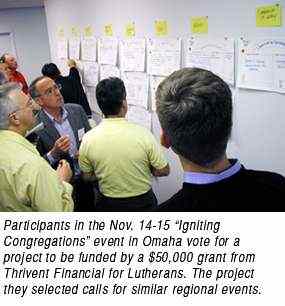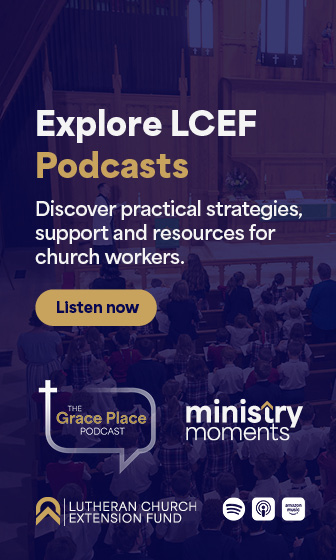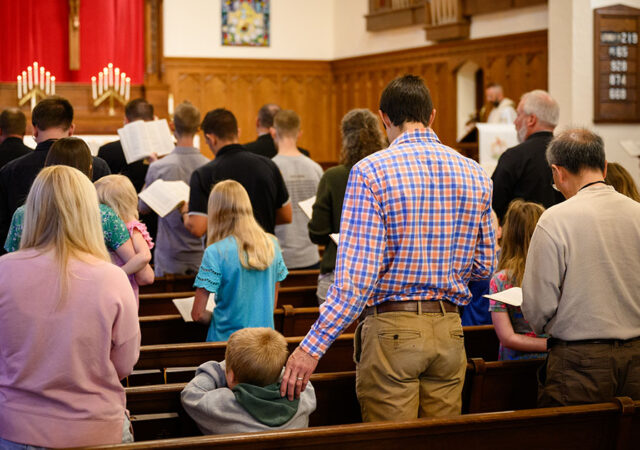 By Joe Isenhower Jr.
By Joe Isenhower Jr.
OMAHA, Neb. — There is no single formula for increasing worship attendance in Synod congregations, but lots of ideas and a range of approaches to share.
That is one way to sum up the Nov. 14-15 “One Mission Ablaze: Igniting Congregations” event at Kings of Kings Lutheran Church here that gathered representatives of 23 Synod congregations among those reporting the highest increases in average worship attendance from 1997 to 2001.
“Whatever is working for you, I pray that your experience will encourage and energize other congregations here and in the Synod,” LCMS President Gerald Kieschnick told the pastors and lay leaders.
This was the third of eight “Igniting” events that are part of Kieschnick’s initiative to “move [the Synod] forward as a dynamic church body that will reach many people for Christ.”
Kieschnick said that surveys indicate that on any given Sunday, only 20 percent of Americans are in church.
“It’s not true that if we build it, they will come,” he said.
“We count people [in church] because people count,” he told the participants. “This is not about doing church, but being church.”
Participants identified “leveraged actions,” or factors influencing worship attendance, including prayer, worship leadership, purpose, outreach, a sense of Christian community, involving youth, service times and styles, lay training, spiritual growth, and networking with growing churches.
They shared what they see as factors for worship-attendance growth in their congregations.
Gloria Dei Lutheran Church, Houston, reported a gain of 576 in its average worship attendance in the four-year period, the largest such gain in the Synod.
Bruce Collett, the congregation’s director of outreach and mission, said Gloria Dei experienced “the beginning of a cultural change” in 2000, when it started a two-year “Each One Reach One” campaign “to raise awareness of each member’s calling to witness and invite people to know Jesus and His church.”
“We were blessed with new members peaking at 367 joining Gloria Dei in 2000 and 314 in 2001,” said Collett, who added that an average of 200 guests and 25 first-time worshipers registered each week for those two years.
“The one constant that I heard throughout the [Igniting] event was that all of the growing churches have leaders who felt committed to do whatever it takes to reach the lost,” said Rev. Paul Hoyer, pastor of Holy Cross Lutheran Church, Lake Mary, Fla.
Hoyer said that a factor for Holy Cross, with a 249 average worship-attendance gain over the four years, was a new sanctuary in 1998 “that allowed us to do the same things that we were doing, only much better.
“I do not think that growth comes from a specific action or program,” said Hoyer, “but rather from an attitude of the leader and the people.”
“I have never conducted my ministry in terms of counting heads at worship services,” said Rev. Steven Briel, pastor of St. John’s Lutheran Church, Maple Grove, Minn., “but solely in terms of preaching the Gospel of our Lord’s forgiveness and salvation as faithfully and clearly as possible and properly administering His holy Sacraments, including an evangelical but careful practice of closed communion.”
St. John’s had an average worship-attendance increase of 196 between 1997 and 2001.
Briel said that factors influencing the congregation’s growth include the growth of the Minneapolis area to the northwest, where Maple Grove is located, and the congregation’s school, which “has attracted many folks ….”
Omaha-event participants were invited to complete “covenant forms” to lead their congregations to greater worship-attendance increases in the next five years, share their expertise in worshipattendance growth with four other congregations, and join in an agreed-on project.
The project they adopted late in the event calls for other events “patterned after the Omaha meeting,” involving congregations that they mentor. Agreed-on results are to “multiply [the] ‘Igniting’ experience, networking, mutual encouragement [and] creating a culture.”
The project will be funded with a $50,000 grant from Thrivent Financial for Lutherans.
“This is serious business,” Kieschnick said as the event closed. “The kinds of resources and gifts obvious in this room can have a tremendous impact on the body of Christ.”
Although dates and the location are not set, the next “Igniting” event will concentrate on the average worship-attendance increase of congregations in non-metropolitan areas over a five-year period.
December 2003




